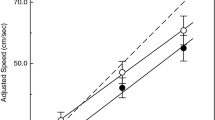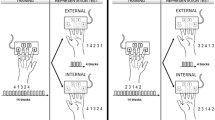Abstract
Tactile perceptual learning has been shown to improve performance on tactile tasks, but there is no agreement about the extent of transfer to untrained skin locations. The lack of such transfer is often seen as a behavioral index of the contribution of early somatosensory brain regions. Moreover, the time course of improvements has never been described explicitly. Sixteen subjects were trained on the Ludvigh task (a tactile vernier task) on four subsequent days. On the fifth day, transfer of learning to the non-trained contralateral hand was tested. In five subjects, we explored to what extent training effects were retained approximately 1.5 years after the final training session, expecting to find long-term retention of learning effects after training. Results showed that tactile perceptual learning mainly occurred offline, between sessions. Training effects did not transfer initially, but became fully available to the untrained contralateral hand after a few additional training runs. After 1.5 years, training effects were not fully washed out and could be recuperated within a single training session. Interpreted in the light of theories of visual perceptual learning, these results suggest that tactile perceptual learning is not fundamentally different from visual perceptual learning, but might proceed at a slower pace due to procedural and task differences, thus explaining the apparent divergence in the amount of transfer and long-term retention.


Similar content being viewed by others
Notes
One subject (subject 15) was excluded from the analysis due to a missing value for the last staircase of the non-dominant hand on the fifth day.
Abbreviations
- ANOVA:
-
Analysis of variance
- BSRD:
-
Between Session Relative Decrease
- LI:
-
Learning Index
- RA:
-
Rapidly adapting
- RHT:
-
Reverse hierarchy theory
- SA1:
-
Slowly adapting type 1
- S1:
-
Primary somatosensory cortex
- S2:
-
Secondary somatosensory cortex
- WSRD:
-
Within-Session Relative Decrease
References
Aberg KC, Tartaglia EM, Herzog MH (2009) Perceptual learning with Chevrons requires a minimal number of trials, transfers to untrained directions, but does not require sleep. Vis Res 49(16):2087–2094. doi:10.1016/j.visres.2009.05.020
Adini Y, Sagi D, Tsodyks M (2002) Context-enabled learning in the human visual system. Nature 415(6873):790–793. doi:10.1038/415790a
Ahissar M, Hochstein S (2004) The reverse hierarchy theory of visual perceptual learning. Trends Cogn Sci 8(10):457–464. doi:10.1016/j.tics.2004.08.011
Ahissar M, Nahum M, Nelken I, Hochstein S (2009) Reverse hierarchies and sensory learning. Philos Trans R Soc Lond B Biol Sci 364:285–299. doi:10.1098/rstb.2008.0253
Ball K, Sekuler R (1987) Direction-specific improvement in motion discrimination. Vis Res 27(6):953–965
Bejjanki VR, Beck JM, Lu ZL, Pouget A (2011) Perceptual learning as improved probabilistic inference in early sensory areas. Nat Neurosci 14(5):642–648. doi:10.1038/nn.2796
Censor N, Sagi D, Cohen LG (2012) Common mechanisms of human perceptual and motor learning. Nat Rev Neurosci 13(9):658–664. doi:10.1038/nrn3315
Crist RE, Kapadia MK, Westheimer G, Gilbert CD (1997) Perceptual learning of spatial localization: specificity for orientation, position, and context. J Neurophysiol 78(6):2889–2894
De Weerd P, Reithler J, van de Ven V, Been M, Jacobs C, Sack AT (2012) Posttraining transcranial magnetic stimulation of striate cortex disrupts consolidation early in visual skill learning. J Neurosci 32:1981–1988. doi:10.1523/JNEUROSCI.3712-11.2011
Dill M, Fahle M (1997) The role of visual field position in pattern-discrimination learning. Proc Biol Sci 264(1384):1031–1036. doi:10.1098/rspb.1997.0142
Dinse HR, Kleibel N, Kalisch T, Ragert P, Wilimzig C, Tegenthoff M (2006) Tactile coactivation resets age-related decline of human tactile discrimination. Ann Neurol 60(1):88–94. doi:10.1002/ana.20862
Dosher BA, Lu ZL (2007) The functional form of performance improvements in perceptual learning rates and transfer. Psychol Sci 18(6):531–539
Duncan RO, Boynton GM (2007) Tactile hyperacuity thresholds correlate with finger maps in primary somatosensory cortex (S1). Cereb Cortex (New York, NY: 1991) 17:2878–2891. doi:10.1093/cercor/bhm015
Fahle M, Edelman S, Poggio T (1995) Fast perceptual learning in hyperacuity. Vis Res 35:3003–3013
Grant AC, Thiagarajah MC, Sathian K (2000) Tactile perception in blind Braille readers: a psychophysical study of acuity and hyperacuity using gratings and dot patterns. Percept Psychophys 62(2):301–312
Harris JA, Harris IM, Diamond ME (2001) The topography of tactile learning in humans. J Neurosci 21(3):1056–1061
Herzog MH, Aberg KC, Fremaux N, Gerstner W, Sprekeler H (2012) Perceptual learning, roving and the unsupervised bias. Vis Res 61:95–99. doi:10.1016/j.visres.2011.11.001
Huang CB, Lu ZL, Dosher BA (2012) Co-learning analysis of two perceptual learning tasks with identical input stimuli supports the reweighting hypothesis. Vis Res 61:25–32. doi:10.1016/j.visres.2011.11.003
Johansson RS (1978) Tactile sensibility in the human hand: receptive field characteristics of mechanoreceptive units in the glabrous skin area. J Physiol 281:101–125
Johansson RS, Vallbo AB (1979) Tactile sensibility in the human hand: relative and absolute densities of four types of mechanoreceptive units in glabrous skin. J Physiol 286:283–300
Kalisch T, Tegenthoff M, Dinse HR (2007) Differential effects of synchronous and asynchronous multifinger coactivation on human tactile performance. BMC Neurosci 8:58. doi:10.1186/1471-2202-8-58
Karni A, Bertini G (1997) Learning perceptual skills: behavioral probes into adult cortical plasticity. Curr Opin Neurobiol 7(4):530–535
Karni A, Sagi D (1991) Where practice makes perfect in texture discrimination: evidence for primary visual cortex plasticity. Proc Natl Acad Sci USA 88(11):4966–4970
Karni A, Sagi D (1993) The time course of learning a visual skill. Nature 365:250–252
Law CT, Gold JI (2008) Neural correlates of perceptual learning in a sensory-motor, but not a sensory, cortical area. Nat Neurosci 11(4):505–513. doi:10.1038/nn2070
Loomis JM (1979) An investigation of tactile hyperacuity. Sens Process 3:289–302
Mulder-Hajonides van der Meulen WREH (1981) Measurement of subjective sleep quality. Elsevier, Amsterdam
Nagarajan SS, Blake DT, Wright BA, Byl N, Merzenich MM (1998) Practice-related improvements in somatosensory interval discrimination are temporally specific but generalize across skin location, hemisphere, and modality. J Neurosci 18(4):1559–1570
Oldfield RC (1971) The assessment and analysis of handedness: the Edinburgh inventory. Neuropsychologia 9(1):97–113
Otto TU, Herzog MH, Fahle M, Zhaoping L (2006) Perceptual learning with spatial uncertainties. Vision Res 46(19):3223–3233. doi:10.1016/j.visres.2006.03.021
Petrov AA, Dosher BA, Lu ZL (2005) The dynamics of perceptual learning: an incremental reweighting model. Psychol Rev 112(4):715–743. doi:10.1037/0033-295X.112.4.715
Pleger B, Foerster AF, Ragert P, Dinse HR, Schwenkreis P, Malin JP, Nicolas V, Tegenthoff M (2003) Functional imaging of perceptual learning in human primary and secondary somatosensory cortex. Neuron 40:643–653
Ragert P, Kalisch T, Bliem B, Franzkowiak S, Dinse HR (2008) Differential effects of tactile high- and low-frequency stimulation on tactile discrimination in human subjects. BMC Neurosci 9:9. doi:10.1186/1471-2202-9-9
Saarinen J, Levi DM (1995) Perceptual learning in vernier acuity: what is learned? Vis Res 35(4):519–527
Sathian K, Zangaladze A (1997) Tactile learning is task specific but transfers between fingers. Percept Psychophys 59:119–128
Sathian K, Zangaladze A (1998) Perceptual learning in tactile hyperacuity: complete intermanual transfer but limited retention. Exp Brain Res 118:131–134
Schoups AA, Vogels R, Orban GA (1995) Human perceptual learning in identifying the oblique orientation: retinotopy, orientation specificity and monocularity. J Physiol 483(Pt 3):797–810
Schoups A, Vogels R, Qian N, Orban G (2001) Practising orientation identification improves orientation coding in V1 neurons. Nature 412(6846):549–553. doi:10.1038/35087601
Schwartz S, Maquet P, Frith C (2002) Neural correlates of perceptual learning: a functional MRI study of visual texture discrimination. Proc Natl Acad Sci USA 99(26):17137–17142. doi:10.1073/pnas.242414599
Seitz AR, Dinse HR (2007) A common framework for perceptual learning. Curr Opin Neurobiol 17(2):148–153. doi:10.1016/j.conb.2007.02.004
Spengler F, Roberts TP, Poeppel D, Byl N, Wang X, Rowley Ha, Merzenich MM (1997) Learning transfer and neuronal plasticity in humans trained in tactile discrimination. Neurosci Lett 232:151–154
Stilla R, Hanna R, Hu X, Mariola E, Deshpande G, Sathian K (2008) Neural processing underlying tactile microspatial discrimination in the blind: a functional magnetic resonance imaging study. J Vis 8(10):13 11–19. doi:10.1167/8.10.13
Tartaglia EM, Aberg KC, Herzog MH (2009) Perceptual learning and roving: stimulus types and overlapping neural populations. Vis Res 49(11):1420–1427. doi:10.1016/j.visres.2009.02.013
Watanabe T, Nanez JE Sr, Koyama S, Mukai I, Liederman J, Sasaki Y (2002) Greater plasticity in lower-level than higher-level visual motion processing in a passive perceptual learning task. Nat Neurosci 5(10):1003–1009. doi:10.1038/nn915nn915
Wilson HR (1986) Responses of spatial mechanisms can explain hyperacuity. Vis Res 26(3):453–469
Wright BA, Sabin AT (2007) Perceptual learning: how much daily training is enough? Exp Brain Res 180(4):727–736. doi:10.1007/s00221-007-0898-z
Xiao LQ, Zhang JY, Wang R, Klein SA, Levi DM, Yu C (2008) Complete transfer of perceptual learning across retinal locations enabled by double training. Curr Biol 18(24):1922–1926. doi:10.1016/j.cub.2008.10.030
Yotsumoto Y, Watanabe T, Sasaki Y (2008) Different dynamics of performance and brain activation in the time course of perceptual learning. Neuron 57(6):827–833. doi:10.1016/j.neuron.2008.02.034
Yotsumoto Y, Sasaki Y, Chan P, Vasios CE, Bonmassar G, Ito N, Nanez JE Sr, Shimojo S, Watanabe T (2009) Location-specific cortical activation changes during sleep after training for perceptual learning. Curr Biol 19(15):1278–1282. doi:10.1016/j.cub.2009.06.011
Zhang JY, Zhang GL, Xiao LQ, Klein SA, Levi DM, Yu C (2010a) Rule-based learning explains visual perceptual learning and its specificity and transfer. J Neurosci 30(37):12323–12328. doi:10.1523/JNEUROSCI.0704-10.2010
Zhang T, Xiao LQ, Klein SA, Levi DM, Yu C (2010b) Decoupling location specificity from perceptual learning of orientation discrimination. Vis Res 50(4):368–374
Zhou Y, Huang C, Xu P, Tao L, Qiu Z, Li X, Lu Z-L (2006) Perceptual learning improves contrast sensitivity and visual acuity in adults with anisometropic amblyopia. Vis Res 46(5):739–750
Acknowledgments
The authors gratefully acknowledge the support of the BrainGain Smart Mix Programme of the Netherlands Ministry of Economic Affairs and the Netherlands Ministry of Education, Culture and Science. We thank Caroline Benjamins and Bart Aben for their help in data acquisition, Prof. Jack Loomis for his advice and Prof. Krish Sathian for providing details on his stimulus design.
Author information
Authors and Affiliations
Corresponding author
Electronic supplementary material
Below is the link to the electronic supplementary material.
221_2012_3329_MOESM2_ESM.tif
Supplementary material figure 1: Within-session relative improvement dominant hand The estimated marginal means for the within-session decrease of session one to four for the dominant hand, expressed as the percentage change of staircase two, three and four with respect to the first staircase in the session. The value for the percentage change on the first staircase was set to zero for illustration purposes. The error bars indicate the (between subject) standard error of the mean. (TIFF 310 kb)
221_2012_3329_MOESM3_ESM.tif
Supplementary material figure 2: Learning rate dominant vs. non-dominant hand (on second session) The estimated marginal means for the within-session decrease of the second session of the dominant hand (day 2) and non-dominant hand (day 5), expressed as the percentage change of staircase two, three and four with respect to the first staircase in the session. The value for the percentage change on the first staircase was set to zero for illustration purposes. The error bars indicate the (between subject) standard error of the mean. (TIFF 486 kb)
Rights and permissions
About this article
Cite this article
Kaas, A.L., van de Ven, V., Reithler, J. et al. Tactile perceptual learning: learning curves and transfer to the contralateral finger. Exp Brain Res 224, 477–488 (2013). https://doi.org/10.1007/s00221-012-3329-8
Received:
Accepted:
Published:
Issue Date:
DOI: https://doi.org/10.1007/s00221-012-3329-8




